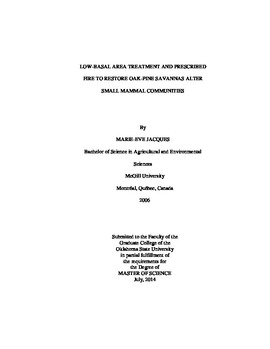| dc.contributor.advisor | Hallgren, Stephen W. | |
| dc.contributor.author | Jacques, Marie-Eve | |
| dc.date.accessioned | 2015-06-17T20:06:24Z | |
| dc.date.available | 2015-06-17T20:06:24Z | |
| dc.date.issued | 2014-07-01 | |
| dc.identifier.uri | https://hdl.handle.net/11244/14903 | |
| dc.description.abstract | Following decades of fire suppression, many savanna ecosystems have changed drastically to dense forests. Restoration of these ecosystems is seen as a way to reduce woody encroachment, dangerous fuel loads, and loss of biological diversity. The management practices to achieve these goals, thinning and prescribed fire, have the potential to affect small mammal communities. Because small mammals exercise key ecosystem functions, changes in their community structure and in their habitat use through the direct and indirect effects of land management practices should be monitored carefully. The overall goal of this research was to determine the effects of low-basal area (BA) practices (thinning and prescribed fire) on small mammal communities in southeast Oklahoma. First, I determined how low-BA practices altered small mammal habitat. Low-BA practices significantly changed dominant ground covers and reduced litter and duff depths, BA of live trees, and the distance of vulnerability (DOV), a measure of understory vegetation structure and animal vulnerability to terrestrial predators. Overall, my results showed that low-BA practices increased ground layer productivity. Second, I assessed whether low-BA management practices altered the community structure of small mammal species in southeast Oklahoma. I found significant differences between the small mammal communities of thinned stands that were burned frequently (low-BA stands) and stands that were not thinned recently and not burned as frequently (high-BA stands). Significant differences in the capture rates of Peromyscus leucopus were documented and differences in the community assemblage between low- and high-BA stands were recorded. Third, I determined habitat preferences of three common small mammal species in southeast Oklahoma: P. leucopus, P. maniculatus, and R. fulvescens. All species preferentially selected low-BA stands. In low-BA stands, P. leucopus selected sites with higher volumes of coarse woody debris and longer DOV, while P. maniculatus selected sites with shorter DOV. In high-BA stands, P. leucopus selected sites with higher ground cover of down woody debris and longer DOV, while P. maniculatus did not appear to respond to those characteristics. Reithrodontomys fulvescens selected low-BA stands with shorter DOV. Knowing how low-BA practices affect small mammals can inform land managers on how to manage for small mammal diversity. | |
| dc.format | application/pdf | |
| dc.language | en_US | |
| dc.publisher | Oklahoma State University | |
| dc.rights | Copyright is held by the author who has granted the Oklahoma State University Library the non-exclusive right to share this material in its institutional repository. Contact Digital Library Services at lib-dls@okstate.edu or 405-744-9161 for the permission policy on the use, reproduction or distribution of this material. | |
| dc.title | Low-basal Area Treatment and Prescribed Fire to Restore Oak-pine Savannas Alter Small Mammal Communities | |
| dc.type | text | |
| dc.contributor.committeeMember | Hallgren, Stephen W. | |
| dc.contributor.committeeMember | McBee, Karen | |
| dc.contributor.committeeMember | Wilson, Duncan S. | |
| osu.filename | Jacques_okstate_0664M_13507.pdf | |
| osu.accesstype | Open Access | |
| dc.description.department | Natural Resources and Ecology Management | |
| dc.type.genre | Thesis | |
| dc.subject.keywords | management | |
| dc.subject.keywords | peromyscus | |
| dc.subject.keywords | reithrodontomys | |
| dc.subject.keywords | restoration | |
| dc.subject.keywords | rodent | |
| dc.subject.keywords | thinning | |
